How to read the Northern Lights forecast
Learning how to read the Northern Lights forecast is easy! By familiarising yourself with the data, you are very likely to see the aurora. All it takes is a little knowledge.
So you find yourself in Iceland to see the Northern Lights. Excellent! Iceland is one of the best places in the world to catch aurora.
But first, let's get one thing straight. There's no way to predict the Northern Lights with high accuracy more than a 1-3 days in advance. There's also no way to predict the strength of the Northern Lights more than 1-2 hours in advance.
Before you head out
Before you head out, the most important thing to have a look at the cloud cover forecast. If you are heading towards a clear area, make sure you check out road conditions by visiting safetravel.is
Step 1: Check the cloud cover forecast
To see the Northern Lights, you need dark and clear or partly clear skies. That's why you have to look at the cloud cover forecast, which comes from the Icelandic Met Office.
The colours represent different layers of clouds. Purple is low clouds, red is mid clouds while green is high clouds. Is your area blocked by the cloud cover, completely free of clouds or are there openings? Keep in mind that high clouds are often transparent and don't interfere that much.
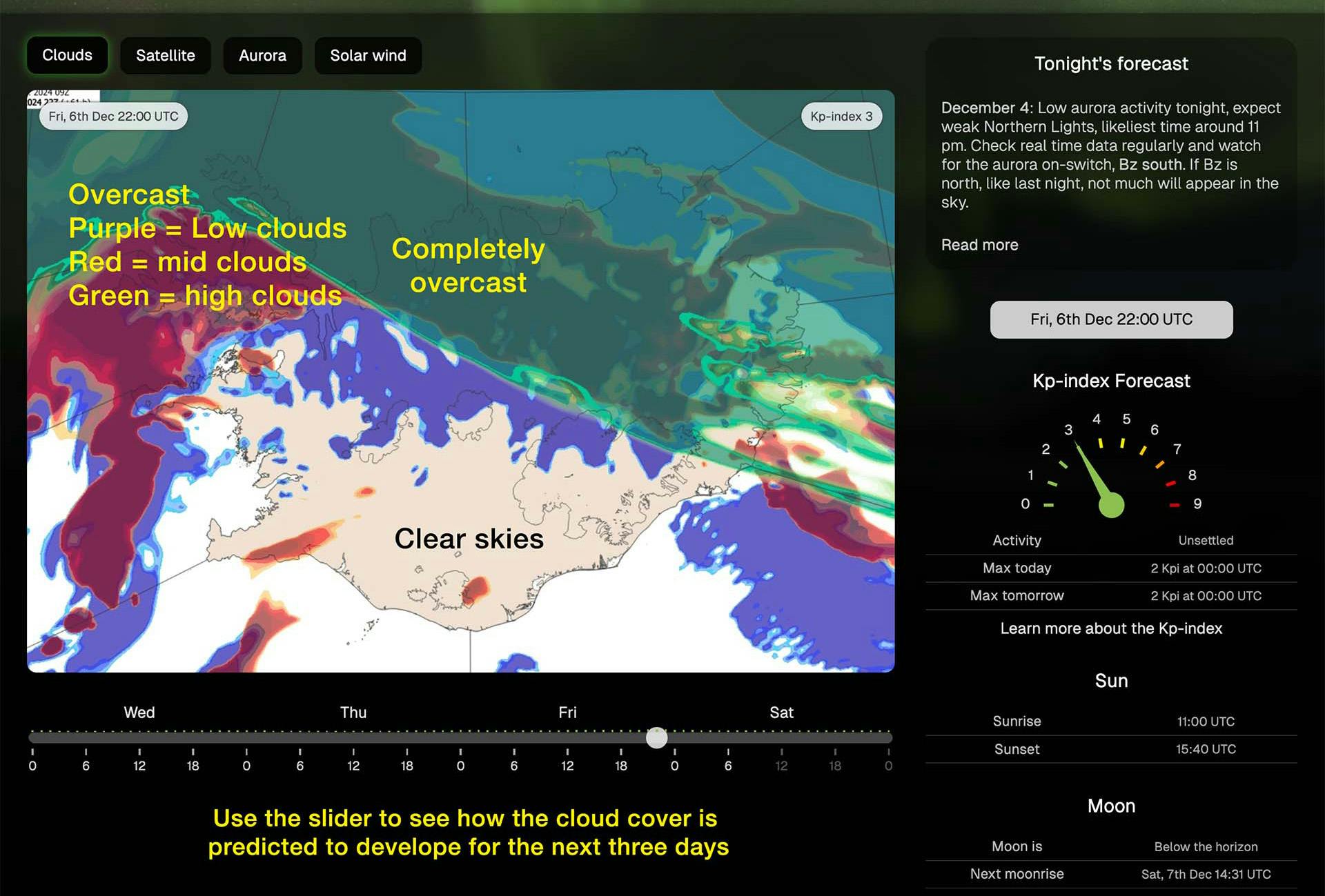
Press the Satellite tab to compare the cloud cover forecast to reality. Sometimes they don’t match. Of course, reality always wins.
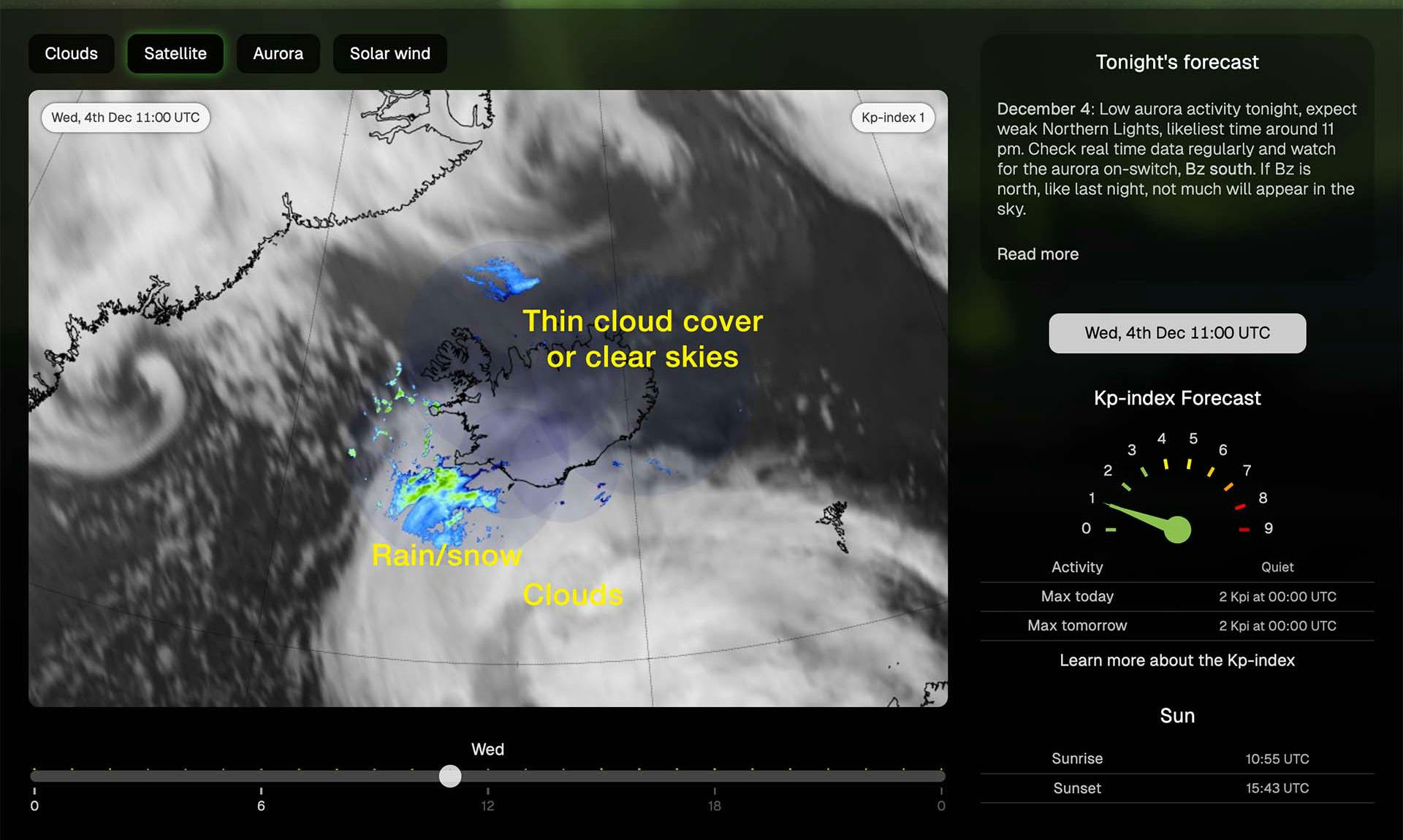
Step 2: Read the Tonight’s forecast summary
Everyday, we have a look at the space weather forecast and the data to write a short description of how tonight might look like.
Now keep in mind that this summary only gives you a rough idea on how tonight might look like based on best available data.
When you're outside under a clear sky
Is the sky clear or partly clear? Great! You are about to start chasing aurora. While you are outside, the most important thing to keep an eye on is the real time space weather data. Don't even bother with the Kp-index. Why? Continue reading.
Step 1: Check the solar wind speed and density
Check the real time space weather data. How fast is the solar wind? Speeds of more than 400 km/s is fast. The faster the better. Is the density high or low? Low density (close to zero) means the colour will likely not be very vibrant. Density values of 5-10 often bring more vibrant colours.
Step 2: Check the auroral oval and hemispheric power index
The hemispheric power index (HPI) is a real-time indicator of how strong aurora will be in about one hour. The higher the number, the stronger the aurora will be.
The hemispheric power index is therefore a good indicator of what to expect. If it's less than 50 GW, activity will be low. If it's above 200 GW, the evening will be excellent, perhaps unforgettable, as long as the solar wind's Bz value is south.
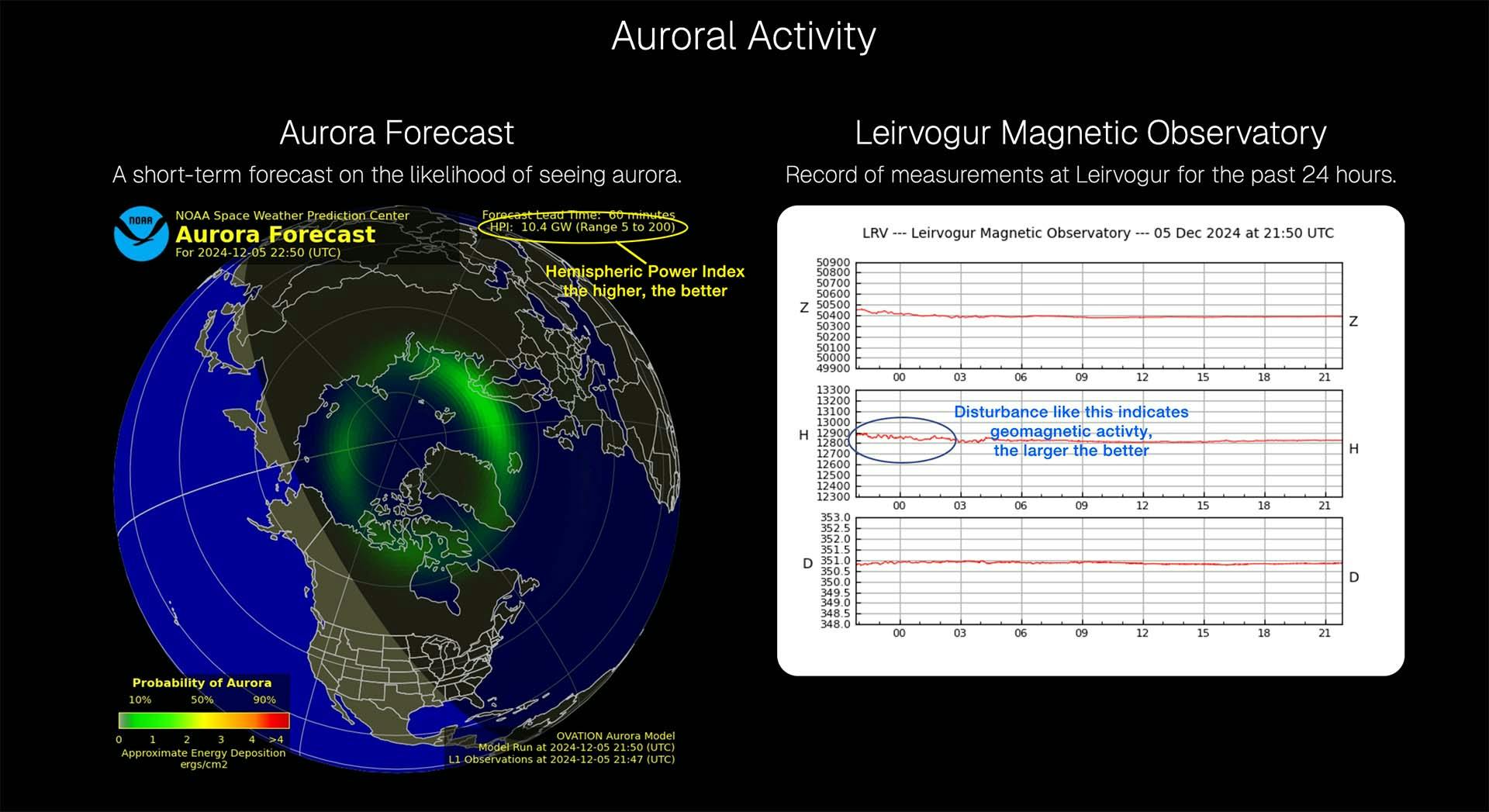
The Ovation auroral oval gives you the likelihood that auroras are in the sky above us. It is usually green but if it's nice and thick with some orange or red regions, you are in for a treat. Iceland usually underneath the most active part of the auroral oval at around 11 pm in the evening. That's why we recommend you stay outside from 10 pm to perhaps 01 am at least.
Step 3: Keep your eyes on the Interplanetary Magnetic Field (most important!)
Is the sky dark and clear and you’re ready embark on an aurora chase? This step is now most important: Focus on the Bz level.
When the mouse is placed over the graph, you’ll see information like Observed time, Arrival time, Bz level and Bt level.
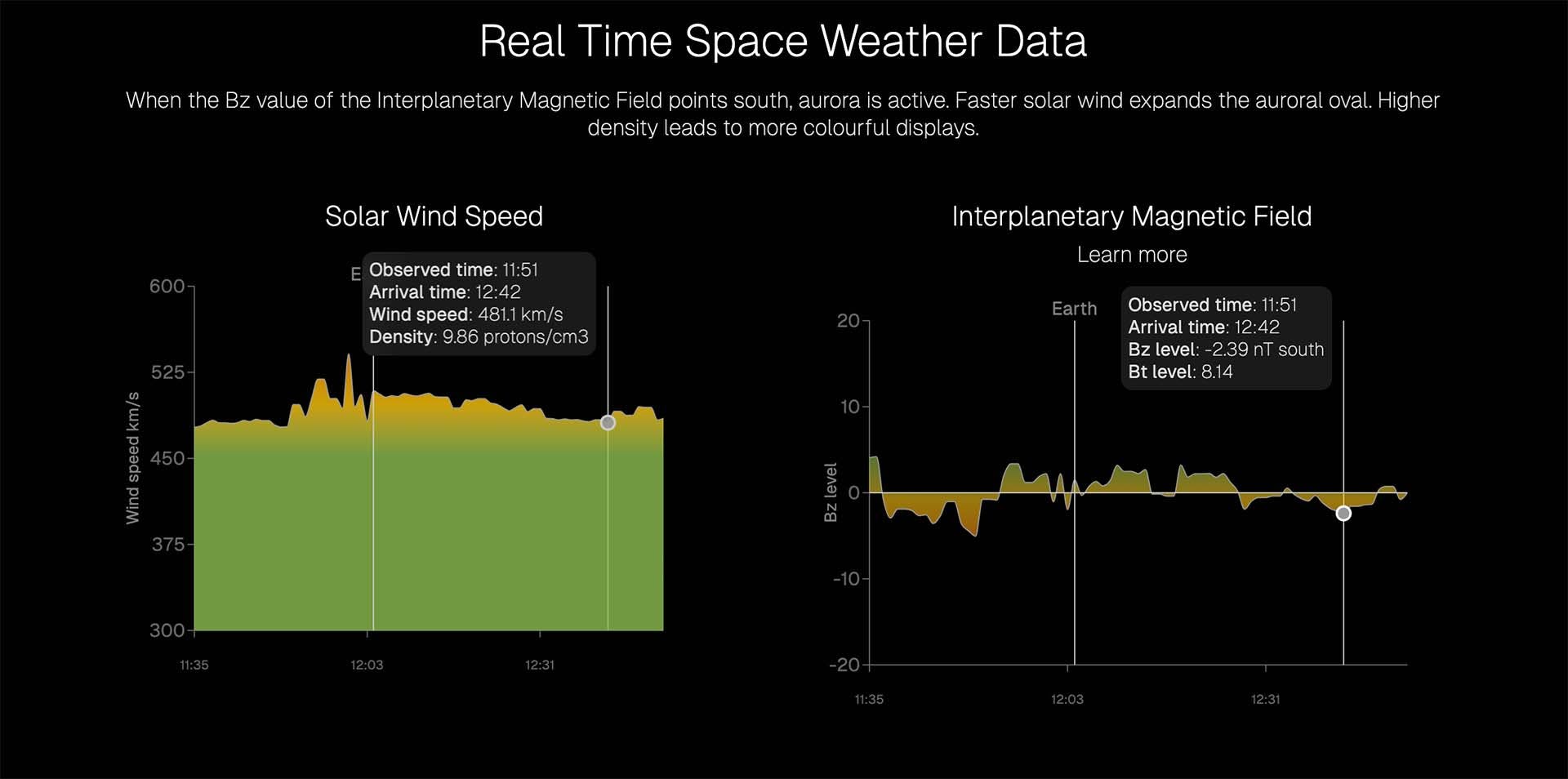
- Observed time shows when the DSCOVR satellite sensed the solar wind
- Arrival time is when that particular solar wind should arrive at Earth and affect it. This is calculated from the speed of the solar wind.
- Bt is the total strength of the magnetic field of the solar wind, the higher the better
- Bz is the north-south orientation of the solar winds magnetic field. A negative south value is great, it’s like an on-switch for the northern lights
By looking at this data, you can see when the northern lights are likely to appear in our skies in the evening. In other words, if the graph is below the zero line for a sustained period of time, you will see a lovely display.
Let’s say that arrival time of a negative Bz south value is 21:45, then you can look to the sky around that time to search for Northern Lights. If the Bz value is positive north, then there’s no reason really to go out and look since the northern lights are off.
Please try your best to learn how to use it and spread the word!
This is the best way to predict the northern lights up to an hour ahead of time.
What about the Kp-index forecast?
Well, the Kp-index is just not very useful for Northern Lights chasers in Iceland. In fact it is almost useless. The Kp-index is not an aurora forecast. At best, it gives you a rough estimate on what to expect.
Iceland is always under the auroral oval. That means the aurora is in the sky every night. When the aurora is faint, it appears as a greyish arc low in the northern sky. When it becomes active, it’s high in the sky and colours become more obvious. We do not need much geomagnetic activity to see lovely lights.
Too often we’ve met people who decided not to bother going outside because they saw a Kp-index forecast of 1, but missed out on a lovely display.
The real time space weather data is much more reliable way to tell you what to expect. And that is exactly what you should focus on.
Tips for Aurora Viewing
- Timing is Key: The aurora can be unpredictable, so keep an eye on Iceland at Night for real-time updates and notifications.
- Find a Dark Spot: City lights can wash out the aurora, so head to a location with minimal light pollution for the best experience.
- Dress Warmly: Aurora viewing often means standing outside for extended periods. Layer up and stay warm.
- Be Patient: Sometimes the aurora takes time to reveal itself. Prepare for a chase of couple of hours - even longer. Stay patient, keep watching the skies, and you may be rewarded with a breathtaking display.
- Watch the real time space weather data: Keep your eyes on the solar wind speed and the north-south direction (Bz value) of the magnetic field; south (negative value) is key.
Note: Aurora forecasts are based on solar activity and weather conditions, both of which can change rapidly. Chasing aurora means sometimes you have to venture outside for an hour or two, even longer and wait for something to appear in the sky.
Interested in taking your own images of the aurora? Follow the steps in our article How to photograph the Northern Lights and you'll have beautiful images to share.
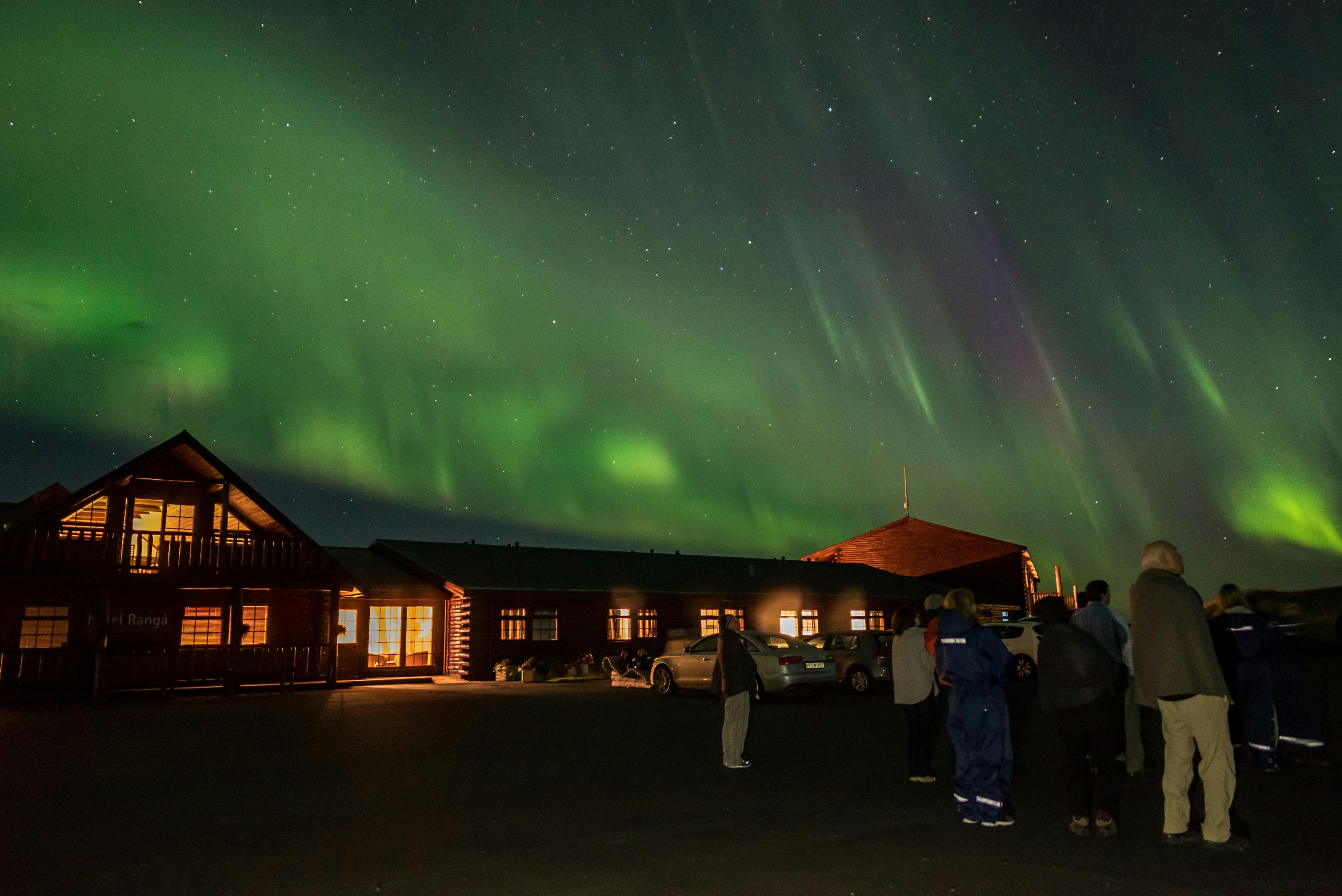
In summary
Check the cloud cover forecast and familiarise yourself with the real time space weather data, especially the importance of Bz south.
Remember to dress warmly, be patient and enjoy all the other beauties of the night sky.
Sævar Helgi Bragason is an award winning astronomy and science communicator and educator, lecturer, author, TV host and owner and editor of icelandatnight.is and eclipse2026.is.


